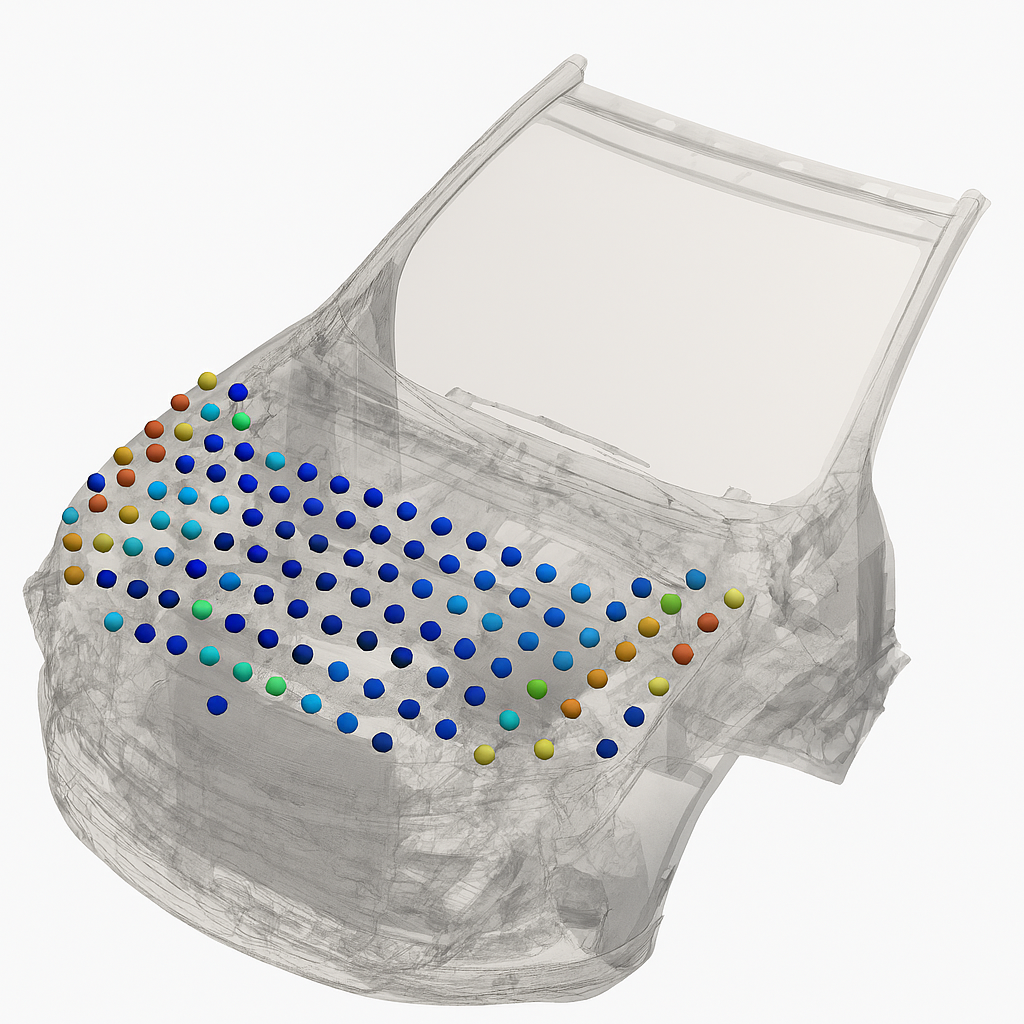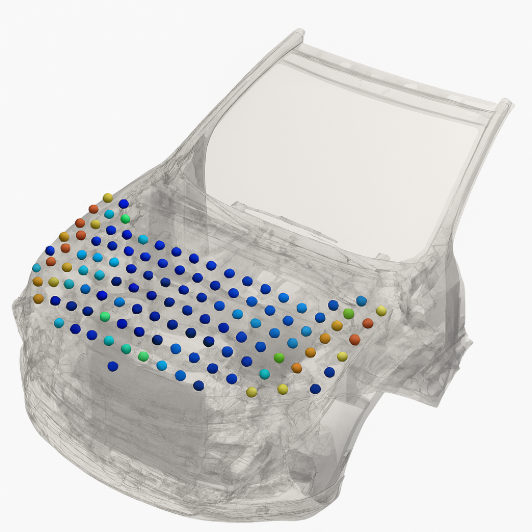Revolutionizing Pedestrian Safety with AI: General Motors with Neural Concept

As automotive competition intensifies—driven by electrification, regulatory pressure, and the rise of China’s OEMs—Western carmakers are racing to reclaim their edge by rethinking how vehicles are engineered.
The key battleground is no longer just hardware, but intelligence: the ability to collapse design cycles, reduce Total Development Effort (TDE), and empower fewer engineers to do more. A new paradigm is emerging, one where data-driven workflows and AI co-pilots transform the V-cycle into a continuous, cross-functional loop—unlocking safer, more aerodynamic vehicles, faster.
At the forefront of this transformation: real-world examples such as General Motors’ work with Neural Concept, showcased at NVIDIA GTC 2025, that demonstrates how Engineering Intelligence is not just a concept—it’s a competitive imperative.
Key outcomes from an industry deployment
- From specialists to design teams: Predictive safety insights are now available early in the process, empowering designers to evaluate trade-offs across styling, safety, and performance.
- Enterprise-scale deployment in motion: in GM's case, the AI co-pilot was trained on 11 vehicle programs, with a roadmap for rollout and embedding it across engineering workflows.
- Weeks to seconds: What once took weeks of simulations is now reduced to real-time feedback, enabling faster, better-informed product decisions.
Engineering's New Layer: Intelligence Over Digitalization
Automotive OEMs, globally, are racing to reduce development time and total development effort (TDE), while electrification, digitalization, and global safety regulations reshape the technological landscape of the industry. Most western OEMs, working with high wages and a more stringent regulatory environment, are viewing AI and automation as their opportunity to compete with Chinese auto makers.
In Engineering, the Intelligence layer is flourishing and building on top of a mostly well established Digitalization layer, built from years of CAD, CAE and PLM development. The promise is to concentrate the standard V-shaped development cycle into the hands of fewer engineers. More explicitly, this means reducing the time and handovers between the design of different components, simulation and validation – empowering a new class of cross-functional engineers who can drive decisions earlier and across disciplines, supported by AI co-pilots. This is made possible by exploiting data-science to facilitate access to broad information in a condensed form, and by freeing the engineer’s mind from implementation details through the support of AI co-pilots.
Showcasing the shift at GTC 2025
The initiative, showcased at Nvidia GTC 2025 by General Motors and built on top of the Neural Concept platform, highlighted the possibility of using AI help to give designers a more fluid access to information about vehicle crash performance, therefore allowing them to guarantee the right level of car safety, while working on other car performance characteristics.
The Challenge of Designing Safer Vehicles at Greater Speed
Pedestrian and cyclist safety are rarely the primary selling arguments for cars. However, strict regulations on the matter might get in the way of other important attributes such as Aerodynamics, Noise or Style.
Limitations of Today’s design Workflows
When designing a new vehicle, OEMs must comply with global vulnerable road user (VRU) regulations, covering both crash mitigation and collision avoidance. Meeting strict global standards such as Global Technical Regulation (GTR) and New Car Assessment Programmes (NCAP) requires numerous design iterations, each one involving hundreds of numerical simulations.
To ensure pedestrian protection, engineers must evaluate hundreds of impact scenarios, different body types (for instance children versus adults), varying speeds and angles, and numerous impact locations across the hood. Each of these scenarios traditionally requires a full-scale finite element analysis (FEA) simulation. These simulations are time and resource-intensive, often taking two hours per test and using up to 256 CPUs per run.
Based on this information, a designer must adapt the design of the car to ensure that regulations are met. However, in the current setting, each iteration might take weeks, relies on the scarce mechanical intuition and gets in the way of other important car attributes. The consequences for the company are dire: many development hours spend in manual work, many meetings between specialists, and, at the end, a sub-optimal decision, potentially compromising on quality.
For instance, a bumpier front-hood might help mitigate the injuries in case impact. However, this might degrade aerodynamics – hence decreasing range – and go against the stylists’ opinion. Pressed by time, overwhelmed by simulation information and being aware that any further iteration would put the project’s timeline in jeopardy, the designer might decide to impose this bumpier front-hood, where a better compromise could have been found.

Transforming Vehicle Design and Simulation Workflows - GM as a case study
Powered by Neural Concept, General Motors set out to transform their capabilities in vehicle design. The goal of the journey is to equip their designers with a 360 view of the design process and make sure that their decisions are assisted by AIs and are fully data-driven.
Training the Co-Pilot: From Data to Decision
The first step towards that goal, was to make NC’s AI co-pilot aware of VRU safety requirements, and able to assess Head Injury Criterion, a critical metric in assessing pedestrian crash safety using AI, rather than relying solely on traditional finite element analysis (FEA).
In GM’s case, engineers fed NC’s AI co-pilot with internal crash simulation data, spanning 11 vehicle programs, regulatory standards (GTR or NCAP), and more than 100 impact locations per vehicle, for both adults and children.
The purpose of the work presented at GTC was to verify that, after having been exposed to this data, NC’s co-pilot was able to assess key safety metrics like Head Injury Criterion for new designs, and therefore to potentially make well informed recommendations for design improvements or trade-offs.
GM’s engineers verified that the model was able to capture nuanced, localized component interactions, such as the influence of wiper motors or latches on hood deformation.
{{highlight}}
The Impact: From Specialists to Organization-Wide Deployment
In this example, the first outcome was the validation of an AI co-pilot specialized in the prediction and improvement of VRU criteria, based on GM’s proprietary crash data. This tool can be used, to start with, by safety engineering specialists as a way to accelerate their daily work, build better recommendations and simulations.
Initially used by VRU safety engineering specialists, the next phase is deploying the AI co-pilot earlier in the design phase: directly into the hands of designers working across disciplines. The goal: to fluidify the end-to-end development chain and collapse the V-cycle, enabling a drastic speed-up in design iteration and a significant reduction in development effort.
'This collaboration is helping us structure and define a roadmap that will enable us to integrate these innovative methodologies effectively across our organization, ensuring we can fully leverage their capabilities to enhance efficiency in enfineering workflows, enabling faster exploration of design possibilities", said Simon Xu at General Motors.
Redefining Roles in an AI-Augmented Workflow
What then will become the role of the crash simulation specialist, as routine work gets absorbed by AI co-pilots? Some of those specialists will focus on improving the AI models, which means building better data collections systems via simulation automation, training and designing better models, as well as supporting designers in collaborating with AI co-pilots. Others will take a more active role in the design process on an everyday basis, injecting quantitative and analytical views into the engineering practice.
“Through our collaboration with Neural Concept, we’ve been able to evaluate the significant value and high potential of AI-driven workflows, particularly in accelerating design processes and predictive modelling”, said Simon Xu, Tech Fellow for Vehicle Optimization and ML at General Motors, shared during the GTC 2025 presentation.



